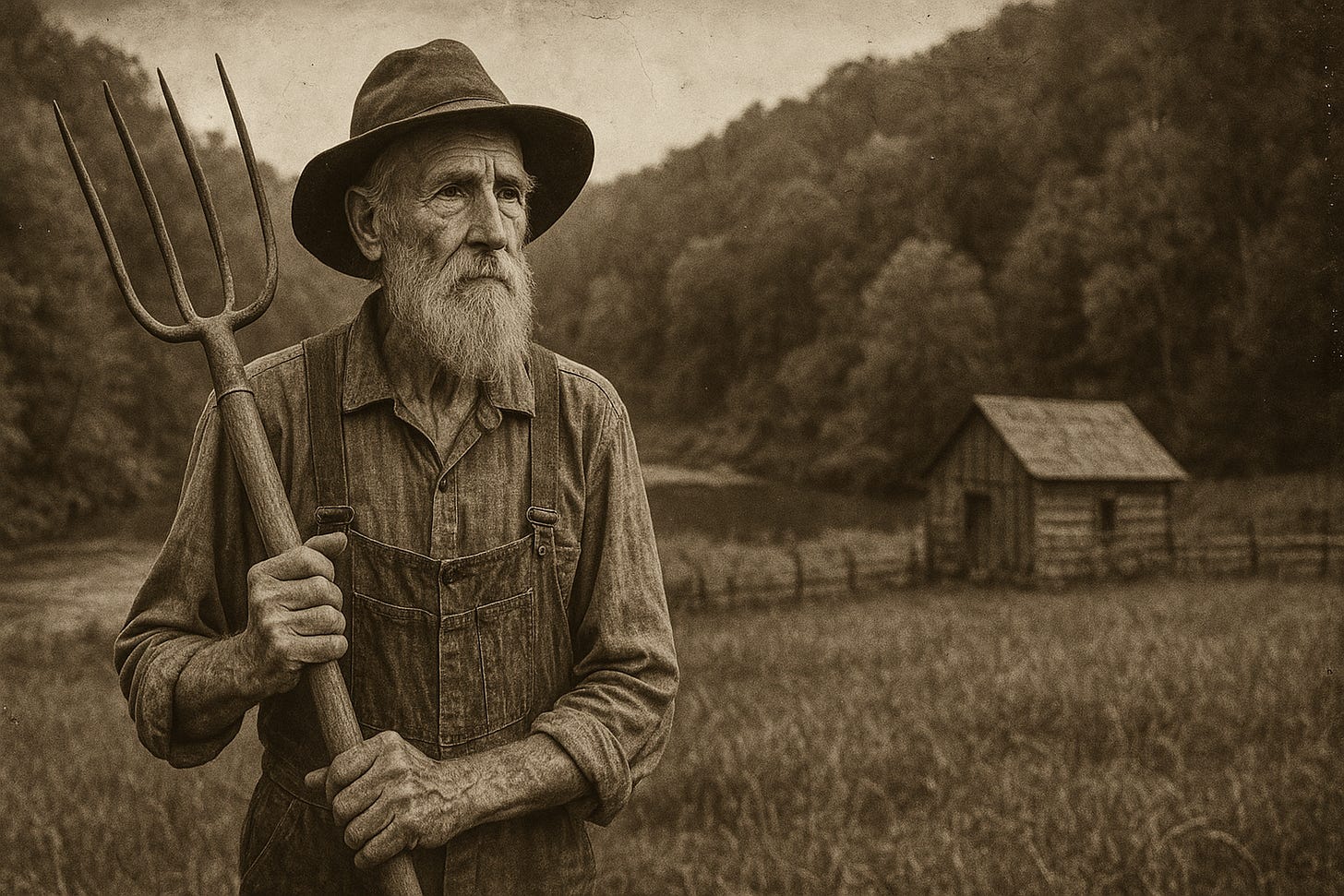You’re reading “Echoes in Time,” a weekly newsletter by the Independent Herald that focuses on stories of years gone by in order to paint a portrait of Scott County and its people. “Echoes in Time” is one of six weekly newsletters published by the IH. You can adjust your subscription settings to include as many or as few of these newsletters as you want. If you aren’t a subscriber, please consider doing so. It’s free!
Today’s newsletter is sponsored by the Scott County Chamber of Commerce. Since 1954, the Scott County Chamber of Commerce has advocated for a strong community by supporting stronger infrastructure and leadership.
Abraham Goad: A forgotten Revolutionary War veteran

As Tennessee celebrates the nation’s semiquincentennial (the 250th anniversary of the nation’s founding in 1776), it will turn to local communities across the state to help tell the stories that are unique to the Volunteer State. And one of the focal points that can be expected for discussion in the months ahead are the state’s Revolutionary War veterans.
Scott County last recognized its Revolutionary War veterans as part of the state’s celebration of America’s 200th anniversary 50 years ago, in 1976. That year, a plaque was placed outside the Scott County Courthouse in Huntsville that included the names of 12 Revolutionary War veterans: Daniel Blevins, William Chambers, James Chitwood, Joseph Griffith, Joseph Hatfield, David Lawson, John Lawson, James McDonald, Joseph McPeters, John Reed, Timothy Sexton and Dennis Trammell.
But there were three veterans of the War of Independence — Abraham Goad, Abel Peak and Randolph Lawson — who were inadvertently left off that plaque. This is the story of one of those three men, Abraham Goad.
It’s a bit of a misnomer to call any of those 15 men “Scott County’s Revolutionary War veterans,” because none of them lived in Scott County when the war broke out in 1776. In fact, Scott County wasn’t formed until 1849 — after all of them had moved to the Cumberland Plateau and after most of them had died. Furthermore, none of them lived in the area that would become Scott County when the war began in 1776. However, these men moved to present-day Scott County soon after the war ended, settling in parts of Campbell, Anderson and Morgan counties that would eventually become Scott County in 1849.
There had been an increase in western exploration in the decades leading up to the war. Dr. Thomas Walker — the man who led the survey team to establish the boundary between Tennessee and Kentucky — had discovered what would come to be called the Cumberland Gap in 1750. Longhunters began passing through the Gap with increasing regularity in the years that followed, including Daniel Boone in the late 1760s. By 1772, a group of longhunters that included individuals named Phillips, Bledsoe and Russell established a camp at the present-day site of Charit Creek Lodge in the Big South Fork National River & Recreation Area, which is how Station Camp Creek got its name.
When the war began, the longhunters went home and joined state militias or the Continental Army to fight against the British. And, when the war ended and America’s independence was solidified, many of those same men packed up their families and their belongings and moved through the Cumberland Gap to establish permanent residences in the great frontier west of the mountains.
Many multi-generational Scott Countians are descended from the Revolutionary War veterans who moved to this area after the war, and most who can trace their ancestry to one of those war veterans can trace it to at least two of them, as several sons and daughters of the Revolutionary War veterans who moved here after the war wound up marrying.
The story of Abraham Goad
Born in Luneburg County, Va. on April 11, 1740, Abraham Goad was the oldest of the Revolutionary War veterans who later moved to Scott County. He was the son of John Goad (1700-1771) and Catherine Jennings (1703-1741), and was in his mid 30s when the war began.
Abraham Goad married Ann Ayers (1740-1788) in 1764. They had at least four children: Anna (1767-1850), Mary (1770-1840), Ayers (1780-1855) and Joshua (1786-1880). However, that number may have been far higher. Some sources cite at least 13 children being born to Abraham and Ann Ayers Goad. Other children may have included James Goad, Catherine Nester, Isham Goad, John Goad, Hiram Goad, Abraham Goad Jr., William Goad, Robert Goad and Elizabeth Hughett.
Goad had a sister, Joannah, who was the mother of John Sevier — the first governor of Tennessee and the man for whom Sevierville (and Sevier County) were named. She spent her entire life in Virginia, which is where John Sevier was born. Her son later moved to Tennessee and became a famed Indian hunter.
Yes, Scott County’s own Abraham Goad was the uncle of Tennessee’s first governor, John Sevier.
We don’t know much about Goad’s service during the war, other than that he served in the Virginia militia. According to his headstone, he served in “Bobbet’s Co.” He was listed on Virginia militia lists in both 1778 and 1781, indicating a long tenure of service during the war.
The move to Tennessee
Abraham Goad moved to Tennessee in about 1803. Although the exact date isn’t known, it’s easy to track his records in Virginia because he was such a prolific property owner, buying and selling hundreds of acres throughout the 1770s, 1780s and 1790s. He last appeared in Virginia in 1802, purchasing 190 acres of property. He first appeared in Tennessee in 1808, purchasing 100 acres on the “Cumberland River” in Anderson County.
That Cumberland River entry was actually New River, south of Huntsville. Abraham Goad lived on what later became known as the Vanderpool Farm. In later records that same year, the area was correctly referred to as “New River,” and states that Goad’s 100 acres included “the bend.” This is likely a reference to the unique “V” shape formed by New River as it curves around what is now known as the Vanderpool Farm, property owned today by Steve and Marla Howard of Huntsville. A couple of years later, a reference was made to property purchased by Goad on Paint Rock Creek in Overton County. The Overton County reference was incorrect; the area now known as Scott County was originally part of Overton County if you trace it back to the 1790s, before Anderson County and, later, Campbell County, were formed.
Listed as a chainman (surveyor) on more than one of Abraham Goad’s plots of land was Randolph Lawson. He was a fellow Revolutionary War veteran who purchased a small plot of land on Paint Rock Creek. Like Goad, he was inadvertently left off that 1976 plaque at the Scott County Courthouse, though two of his brothers — David Lawson and John Lawson — were included.
Making the move to Tennessee with Abraham Goad was his son, Joshua Goad, and two of his daughters, Anna and her husband, Robert Lawson, and Mary and her husband, Thomas Phillips. Also making the journey was Thomas Phillips’ brother, Joseph Phillips, who was only about 15 at the time. Thomas and Joseph were the sons of Tobias Phillips, a Revolutionary War veteran who did not make the move to Scott County.
Shortly after the move to Scott County, Joseph Phillips married Elizabeth “Millie” Lawson, the daughter of Randolph Lawson.
Two questions arise: One, was Robert Lawson — Abraham Goad’s son-in-law — related to the other Lawsons who moved to Scott County at about this time, including Randolph Lawson? Two, was Tobias Phillips — father of Thomas Phillips and Joseph Phillips — the long hunter referenced at Station Camp Creek in 1772? Many of the earliest settlers of Tennessee and other frontier areas west of the mountains were long hunters who returned permanently after the Revolutionary War ended.
The answer to the first question appears to be that Robert Lawson, husband of Abraham Goad’s daughter, Anna, was not related to Randolph Lawson. Robert Lawson’s father appears to have been William Lawson, who migrated from Scotland to Virginia in the late 18th century.
The answer to the second question is anyone’s guess, as we unfortunately do not have the first names of those men who established the station camp in the Big South Fork.
One thing we do know for certain is that Abraham Goad’s wife, Ann, was not part of the caravan to Tennessee. She died in 1788. Some sources say she was buried at the Vanderpool Cemetery on Goad’s New River farm. That is almost certainly inaccurate, since tax records in Virginia show that Goad did not make the move to Tennessee until at least 1802.
Joshua Goad, Abraham Goad’s son who moved to Tennessee with him, married Sarah Smiddy and they had nearly two dozen children. one of them was Joshua Goad Jr., who married Elizabeth Emily Robbins. They moved to Brimstone Creek and established a farm there, about where Indian Fork Creek empties into Brimstone Creek. One of their children was Almira Goad. She married Civil War veteran Daniel Walker in 1866, and they took over the Goa farm on Brimstone Creek. It is still known as the Walker farm to this day.
Another of Joshua and Elizabeth’s children was John Goad, who was elected Scott County Sheriff in 1894 and was the sheriff in charge of Scott County’s only legal hanging. He later served as county trustee and circuit court clerk, and built a home next-door to the Scott County Courthouse where Howard H. Baker would later practice law — next to where the Revolutionary War veterans plaque that inadvertently forgot his great-grandfather would be built many years later.
Yet another of Joshua and Elizabeth’s children was Etta Tennessee Goad, who married Scott County School Superintendent William Lee. She was the mother of Cassie Goad Duncan, the mother of Knoxville Mayor and U.S. Congressman John J. Duncan Sr.
Mary Goad Phillips, Abraham Goad’s daughter who married Thomas Phillips, settled in the Paint Rock Creek area. Her children included Johnathan Phillips, Emanuel Phillips and Elijah Phillips. Emanuel was one of the many Scott Countians who died of illness while serving in the Civil War. He died of smallpox and was buried at Knoxville National Cemetery.
Joseph Phillips, who moved to Scott County as part of the group and married Millie Lawson, settled on Bull Creek. One of their children was Jehu Phillips, one of Scott County’s early elected officials.
Abraham Goad died in 1816 and was buried at Vanderpool Cemetery. His grave is the oldest identifiable grave currently known to exist in Scott County. (James Trammell, son of Revolutionary War veteran Dennis Trammell, was buried at Angel-Wright Cemetery at Angel Valley near Winfield in 1826. His headstone is the earliest identifiable original headstone in Scott County. Abraham Goad’s headstone isn’t original; it was placed many years after his death. There’s a broken headstone in the Davis Cemetery off Alderville Road in Winfield that is dated 1812 and may be the oldest known headstone in Scott County. However, it is unidentifiable.)
Thank you for reading. Our next newsletters will be Threads of Life on Wednesday and The Weekender Thursday evening. Want to update your subscription to add or subtract these newsletters? Do so here. Need to subscribe? Enter your email address below!
◼️ Monday morning: The Daybreaker (news & the week ahead)
◼️ Tuesday: Echoes in Time (stories of our history)
◼️ Wednesday: Threads of Life (obituaries)
◼️ Thursday evening: The Weekender (news & the weekend)
◼️ Friday: Friday Features (beyond the news)
◼️ Sunday: Varsity (a weekly sports recap)




Thank you for writing this article. It was very informational. It has a few of my ancestors listed, including old Abraham Goad. He certainly needs to be added to a plaque along with his other two soldiers who were not included. Maybe we can fix that one day. Thanks again, Christine in Virginia